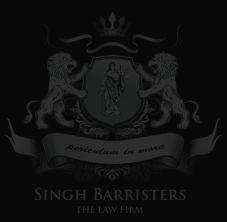| Toll Free : 1844 495 7333(injury hotline- new cases only) | |
| Text a Personal Injury Lawyer 24/7 and get instant help.TM (416 931 5015) | |
| Head Office : 905 495 7333 |
Shillingtons LLP Insurance Law Bulletin – January 2012 – SABS Catastrophic Impairment Update
July 26, 2016The legal community had been concerned about the “Recommendations for Changes to the Definition of Catastrophic Impairment” report released by an expert panel set up by the Financial Services Commission of Ontario.
The Ontario Court of Appeals on December 23, 2011, released its decision in Kusnierz vs The Economic Mutual Insurance Company. The issue on hand was whether physical and psychological impairment are to be combined while determining if a person is “catastrophically impaired” as it relates to the “impairment of the whole person” under Section 2 (1.1) (f) of the Statutory Accident Benefits Schedule (SABS).
This case has far-reaching implications for the issues in question. The Appeal Court also made important remarks on what determinants were to be used while making decisions concerning catastrophic impairment. Contact a top personal injury lawyer from Ontario to know more.
Kusnierz vs The Economic Mutual Insurance Company
On December 24, 2001, Robert Kusnierz was a passenger in a single-vehicle accident (a rollover) and suffered serious injuries including amputation. Subsequently, Kusnierz suffered cysts and deterioration of the amputated stump of his leg, problems arising from a poorly-fitted prosthesis and pain. He also developed clinical depression.
Kusnierz claimed accident benefits from The Economic Mutual Insurance Company. It’s important to know how to find the best accident injury lawyer in such cases.
The trial judge who interpreted and upheld the relevant sections of the SABS regulations held that behavioral and mental impairments and physical impairments could not be combined to achieve a 55% whole person impairment (which is required by SABS regulations for awarding benefits) and therefore Kusnierz’s injuries could not be classified as “catastrophic impairment.”
The case was appealed and the Ontario Court of Appeals unanimously reversed the decision of the trial judge. The court opined that the intention of the drafters of SABS was to be ‘inclusive’ and not ‘restrictive’ and the broad definition of “catastrophic impairment” includes “loss or abnormality of a psychological, physiological or anatomical structure or function.”
The Court of Appeal found that combining impairments was not inconsistent with the purpose of SABS and that though catastrophic designations should be rare and exceptional, following the guidelines would in fact ensure that only very few cases would meet the threshold requirement of permanence and a combined rating of 55% impairment.
Impact of The Decision
The Kusnierz case represents significant clarifications of ambiguities of SABS. This decision confirms that accident victims no longer have to establish catastrophic impairment on the basis of either physiological or psychological impairments alone, but both categories can be combined to determine whether the victim is entitled to the protection provided by the designation of “catastrophic impairment.”
Conclusion
The present decision represents a more expansive view of the term. It also represents the issues that occur due to the reliance on the American Medical Association’s Guides to the Evaluation of Permanent Impairment (1993) since the Guides are not legislative instruments and they derive from outside Ontario. Hence, there was an effort by the court to balance the shortfall of benefits with the future ability to secure additional funding in such cases of catastrophic impairment, which may require life-long medical attention and care.
If you, your family or a friend has been injured in an accident, please feel free to speak to one of our injury lawyers for a free consultation about how we are able to assist in making a claim. We consult in all cities across Ontario with a no win no fee guarantee. Our personal injury lawyers have helped victims secure millions of dollars in personal injury cases. Call us Toll Free On our 24/7 Injury Hotline: 1 – 844 495 7333 or Text a Personal Injury Lawyer 24/7 and get instant help. (416 931 5015)
Shillingtons LLP Insurance Law Bulletin – January 2012 – SABS Catastrophic Impairment Update
July 26, 2016The legal community had been concerned about the “Recommendations for Changes to the Definition of Catastrophic Impairment” report released by an expert panel set up by the Financial Services Commission of Ontario.
The Ontario Court of Appeals on December 23, 2011, released its decision in Kusnierz vs The Economic Mutual Insurance Company. The issue on hand was whether physical and psychological impairment are to be combined while determining if a person is “catastrophically impaired” as it relates to the “impairment of the whole person” under Section 2 (1.1) (f) of the Statutory Accident Benefits Schedule (SABS).
This case has far-reaching implications for the issues in question. The Appeal Court also made important remarks on what determinants were to be used while making decisions concerning catastrophic impairment. Contact a top personal injury lawyer from Ontario to know more.
Kusnierz vs The Economic Mutual Insurance Company
On December 24, 2001, Robert Kusnierz was a passenger in a single-vehicle accident (a rollover) and suffered serious injuries including amputation. Subsequently, Kusnierz suffered cysts and deterioration of the amputated stump of his leg, problems arising from a poorly-fitted prosthesis and pain. He also developed clinical depression.
Kusnierz claimed accident benefits from The Economic Mutual Insurance Company. It’s important to know how to find the best accident injury lawyer in such cases.
The trial judge who interpreted and upheld the relevant sections of the SABS regulations held that behavioral and mental impairments and physical impairments could not be combined to achieve a 55% whole person impairment (which is required by SABS regulations for awarding benefits) and therefore Kusnierz’s injuries could not be classified as “catastrophic impairment.”
The case was appealed and the Ontario Court of Appeals unanimously reversed the decision of the trial judge. The court opined that the intention of the drafters of SABS was to be ‘inclusive’ and not ‘restrictive’ and the broad definition of “catastrophic impairment” includes “loss or abnormality of a psychological, physiological or anatomical structure or function.”
The Court of Appeal found that combining impairments was not inconsistent with the purpose of SABS and that though catastrophic designations should be rare and exceptional, following the guidelines would in fact ensure that only very few cases would meet the threshold requirement of permanence and a combined rating of 55% impairment.
Impact of The Decision
The Kusnierz case represents significant clarifications of ambiguities of SABS. This decision confirms that accident victims no longer have to establish catastrophic impairment on the basis of either physiological or psychological impairments alone, but both categories can be combined to determine whether the victim is entitled to the protection provided by the designation of “catastrophic impairment.”
Conclusion
The present decision represents a more expansive view of the term. It also represents the issues that occur due to the reliance on the American Medical Association’s Guides to the Evaluation of Permanent Impairment (1993) since the Guides are not legislative instruments and they derive from outside Ontario. Hence, there was an effort by the court to balance the shortfall of benefits with the future ability to secure additional funding in such cases of catastrophic impairment, which may require life-long medical attention and care.
If you, your family or a friend has been injured in an accident, please feel free to speak to one of our injury lawyers for a free consultation about how we are able to assist in making a claim. We consult in all cities across Ontario with a no win no fee guarantee. Our personal injury lawyers have helped victims secure millions of dollars in personal injury cases. Call us Toll Free On our 24/7 Injury Hotline: 1 – 844 495 7333 or Text a Personal Injury Lawyer 24/7 and get instant help. (416 931 5015)








